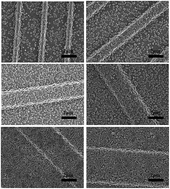Growth and characterization of zeolitic imidazolate framework-8 nanocrystalline layers on microstructured surfaces for liquid crystal alignment†
Abstract
Zeolitic imidazolate framework-8 (ZIF-8) nanocrystalline layers were grown on carboxylate-terminated sol–gel films patterned with surface-relief microstructures. The coverage of ZIF-8 nanocrystals was significantly affected by the surface morphology, like the size and interspace of microstructures. Its vertically aligning ability to a typical nematic liquid crystal (LC) E7 was verified and its applications as a hybrid aligned nematic (HAN) LC cell-based voltage-dependent light modulator and a switchable diffraction grating were demonstrated.


 Please wait while we load your content...
Please wait while we load your content...